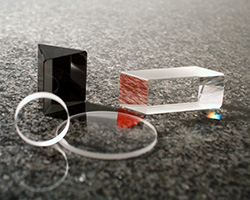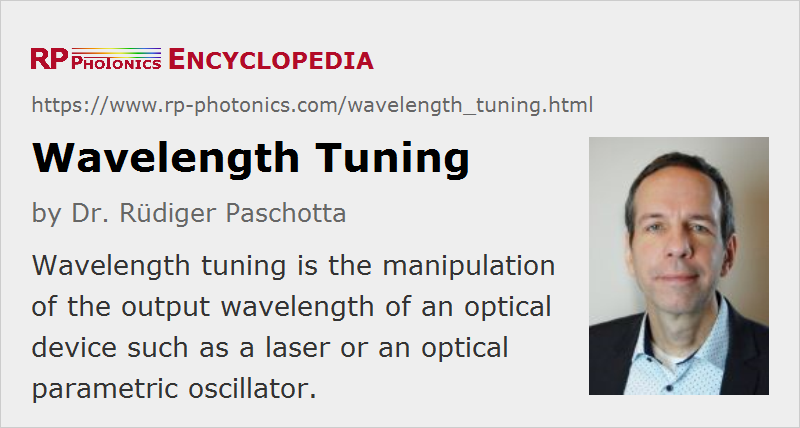Wavelength Tuning
Definition: the manipulation of the output wavelength of an optical device such as a laser or an optical parametric oscillator
German: Wellenlängen-Einstellung
Categories:  laser devices and laser physics,
laser devices and laser physics,  methods
methods
Author: Dr. Rüdiger Paschotta
Cite the article using its DOI: https://doi.org/10.61835/u7k
Get citation code: Endnote (RIS) BibTex plain textHTML
For some applications, it is required that the wavelength (and thus the optical frequency) of a laser beam can be tuned within some range. Whereas the article on tunable lasers discusses various types of lasers which have an adjustable output wavelength, this article explains several methods of wavelength tuning.
Tuning via the Gain Medium
The first method is to influence the laser gain medium in such a way that the wavelength of maximum gain is changed, and the output wavelength changes accordingly (Figure 1). This method is often applied to lasers with operation on multiple resonator modes, where the “center of gravity” of the optical spectrum may be tuned fairly continuously. The method can also be applied to single-frequency lasers, but then it usually leads to mode hopping rather than continuous tuning.

Laser diodes are often tuned via the temperature, e.g. by changing the drive current of a thermoelectric cooler on which the laser diode is mounted, or the drive current of the laser diode itself. Typically, laser diodes tune by ≈ +0.3 nm/K, and the total tuning range achieved in that way may be a few nanometers wide. The resonator mode frequencies are also affected by the temperature change, but they react less strongly than the gain spectrum. In the case of single-frequency operation, continuous tuning over a wider range may be achieved if appropriate measures are taken to appropriate tune the resonance frequencies and suppress mode hopping. For example, the resonator length may be tuned (see below) together with the drive current in the case of an external-cavity diode laser.
Tuning With an Intracavity Filter

The second method is to introduce a tunable optical filter into the laser resonator, which has a pronounced loss minimum at some adjustable wavelength (Figure 2). This makes it possible to influence the wavelength of maximum net gain, at which the laser is usually forced to operate. More precisely, the laser will usually operate on one or several resonator modes for which the inversion level of the gain medium required for lasing (i.e. for generating a gain which equals the resonator losses) is close to its minimum. In the steady state (for continuous-wave operation), light at the laser wavelength has zero round trip net gain, and all other wavelengths experience a negative net gain per resonator round trip (assuming homogeneous broadening of the gain spectrum). Note that even with an only slightly negative net gain, lasing can be completely suppressed.
This method of tuning is often applied to solid-state lasers. A wide wavelength tuning range of a laser requires a wide gain bandwidth of the gain medium. Some broadband gain media such as Ti:sapphire and Cr:ZnSe allow tuning over hundreds of nanometers. The tuning range obtained is usually the wavelength range in which sufficient net gain can be achieved. Its limits are often set by the points where the emission cross-sections become too low or the resonator losses become too high. In some cases, the tuning range may be smaller because there is excited-state absorption, or because parasitic lasing at wavelengths with maximum laser gain can not be sufficiently suppressed. In some fiber lasers, the inversion level (and hence the gain at extreme wavelengths) is limited by amplified spontaneous emission near the wavelength of maximum gain.

The dashed curves were calculated for a reduced output coupler transmission, which broadens the tuning range while compromising the maximum output power.
Frequently used tuning elements in bulk laser resonators are:
- an etalon (Fabry–Pérot interferometer) or a birefringent tuner (Lyot filter) which can be rotated to adjust the wavelength of maximum transmission
- a prism pair in combination with a movable aperture
- a single prism in combination with and end mirror which can be tilted to adjust the wavelength for which the resonator is well aligned
- a volume Bragg grating used as a folding mirror with a variable angle of incidence
External-cavity diode lasers can also be tuned with an intracavity filter. A holographic diffraction grating can be used as an end mirror (Littrow configuration), which is rotated for tuning, or a fixed grating within the resonator combined with a movable end mirror (Littman configuration).
Tuning via the Resonator Length

A single-frequency laser can be tuned within approximately one free spectral range of its resonator by fine adjustment of the resonator length within a range of half a wavelength (for linear resonators) (Figure 4). The principle behind this is that the frequencies of the resonator modes are shifted. Attempts to tune further may cause the laser to mode hop to the next resonator mode, which then has the higher gain. A wider tuning range can be achieved if the wavelength of maximum gain is also tuned, or with an additional intracavity filter.
Relatively wideband mode-hop-free tunability can be obtained with very short laser cavities. This is used with, e.g., MEMS VCSELs, having a separate output coupling mirror the position of which can be tuned via thermal expansion, electrostatic forces, or a piezoelectric element.
Alternative Techniques
Wavelength-tunable radiation can also be obtained with alternative techniques:
- Synchrotron radiation sources (wigglers and undulators, free electron lasers) allow wavelength tuning via the electron energy.
- Optical parametric oscillators are often tuned by affecting the phase-matching conditions.
- An optical parametric amplifier can be used for amplifying a variable part of a very broad spectrum, as obtained via supercontinuum generation. Alternatively, one may just use a supercontinuum source in conjunction with a tunable bandpass filter.
- The Raman self-frequency shift in an optical fiber can be exploited for wavelength tuning via the launched power of the pulses.
If a very fast periodic sweep of the optical frequency is required, an alternative method is available: short optical pulses are fed through a strongly dispersive element (e.g. a long fiber), so that the different wavelength components exit this element at different times.
More to Learn
Encyclopedia articles:
- wavelength
- tunable lasers
- distributed Bragg reflector lasers
- wavelength-swept lasers
- optical filters
Blog articles:
Suppliers
The RP Photonics Buyer's Guide contains ten suppliers for wavelength tuning devices. Among them:


ALPHALAS
Efficient tuning of the emission wavelength of various wideband laser crystals like Ti:sapphire, Yb:YAG, Yb:KGW as well as dye lasers and optical parametric generators is achieved by means of wavelength tuning devices offered by ALPHALAS. These include reflection and transmission diffraction gratings, intracavity etalons, dispersive prisms and Lyot filters. Especially efficient are Brewster-oriented birefringent plates due to the very low losses and wide tuning ranges. These are available from stock with standard thicknesses from 1 mm to 10 mm, but also as customer-specific designs. The offered birefringent materials are crystal quartz for the spectral range 200 … 2600 nm and MgF2 for the extremely wide spectral range from 150 nm to 6500 nm. For far-infrared wavelengths and lasers up to 19 µm, ALPHALAS offers unique IR birefringent Lyot filters.
Questions and Comments from Users
Here you can submit questions and comments. As far as they get accepted by the author, they will appear above this paragraph together with the author’s answer. The author will decide on acceptance based on certain criteria. Essentially, the issue must be of sufficiently broad interest.
Please do not enter personal data here; we would otherwise delete it soon. (See also our privacy declaration.) If you wish to receive personal feedback or consultancy from the author, please contact him, e.g. via e-mail.
By submitting the information, you give your consent to the potential publication of your inputs on our website according to our rules. (If you later retract your consent, we will delete those inputs.) As your inputs are first reviewed by the author, they may be published with some delay.




2023-05-24
Can one tune the wavelength of a laser beam by acting on the beam itself?
The author's answer:
That's difficult. In principle, you could achieve a change of wavelength (or optical frequency) by reflecting the beam off some moving mirror. But you would need a steady movement to achieve a constant frequency offset, for example. Similarly, you could an optical modulator, but as that usually not provide arbitrarily large phase changes, it could only produce a temporary frequency offset.